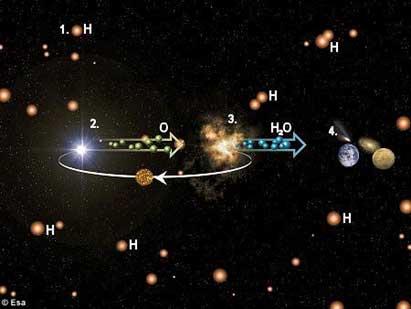Water vapor in space

In space there is more water vapor than was thought so far. In an investigation conducted by the Italian astronomer Andrea Moneti, concrete data have been obtained.
It is very difficult to detect the dispersed water in space. Since the Earth's atmosphere is saturated with water vapor, only such interference can be seen in the devices used by scientists. The solution is to launch spectroscopes out of the atmosphere. The water vapor research has been carried out from the ISO satellite of the ESA. This satellite explores infrared light from space from its orbit.
Like other molecules, water is concentrated in the clouds of space. In these clouds the molecular concentration is very low, but occasionally two atoms of hydrogen bind to one of oxygen forming water molecules.
This water is in two situations in space. The one that is in very cold clouds, at -263º C, is in solid state, that is, in the form of ice. This ice is condensed into dust particles and absorbs light from various wavelengths.
The clouds that have studied those of the Moneti group are of another type. The temperature of these clouds is about 27 °C and when they are loose water molecules form steam. The wavelength of the light absorbed by these molecules is within a narrower range, which facilitates its detection.
For two and a half years, the Moneti team has obtained data from the two space clouds where stars, SgrA and GCS-3 are born. From this data, the density of water molecules in these vapors has been calculated, estimating 20,000 billion molecules per cubic centimeter, more than expected. However, scientists have not surprised much, since water is the typical component of the chemical processes of these clouds. It is known that only carbon monoxide is the only molecule in greater proportion than water.
Buletina
Bidali zure helbide elektronikoa eta jaso asteroko buletina zure sarrera-ontzian











